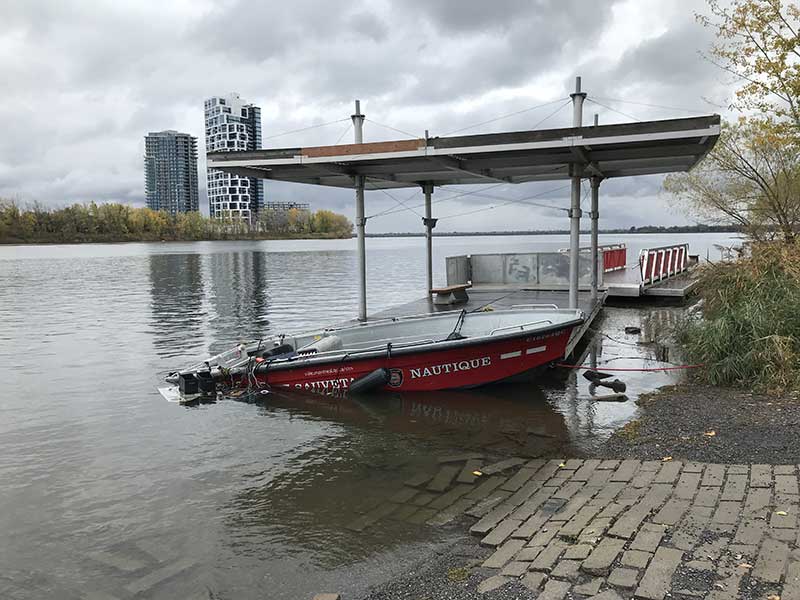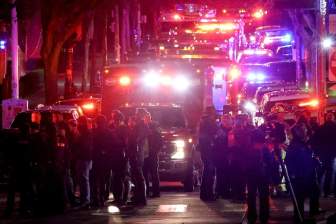Quebec’s work safety board (CNESST) has concluded that the boat that firefighters used during a deadly rescue in the St. Lawrence River and the training they received were deficient.

Pierre Lacroix, 58, was one of four firefighters taking part in a water rescue on Oct. 18 last year in the Lachine Rapids, when the boat they were on capsized after taking on two boaters in distress.
Everyone else was rescued but Lacroix died as he was pinned under the boat.
The board’s investigation found three main culprits:
- The weight distribution on the boat coupled with the intensity of the rapids made the boat capsize as the crew tried to position themselves close to the boat in distress.
- Firefighters intervened while having incomplete information in a dangerous area of the Lachine rapids, which was beyond the limits of the boat’s capacity.
- The team of firefighters as well as the team set up in the command post riverside to assist didn’t have enough training either.
Chris Ross, president of the Montreal Firefighters Association says they’re disappointed with the report.
“There’s no bite to the bark, there’s no obligation for the employer to change anything,” Ross said. “We were expecting that there would be some formal derogation that would’ve forced the employer to bring some changes and give them a certain number of time to put them in place.”
Ross says he would like for the city to implement more and continuing training for water rescues and under a variety of circumstances.
“There is a large distinction between going and practice at 2 o’clock in the afternoon when it’s 30 degrees out, it’s sunny and it’s beautiful to responding at 2 o’clock in the morning when there’s 3-foot waves and it’s raining,” Ross explained.
- Winter storms, rain and snow wallopping Canada. Here’s where you’ll see it
- ‘Really challenging issue’: Many B.C. communities still at high risk for flooding
- Cold warnings across the Prairies forecast wind-chill temperatures near -45 C
- Toronto records lowest hotel price increase among 2026 World Cup host cities
He also says that there needs to be more training about learning the territory because firefighters respond to a wide range of locations in the island of Montreal.
Ross say the officers who were deployed to the command post, as pointed out by the CNESST, didn’t have water rescue training and that also needs to change.
Ross believes that without the aforementioned points in place, firefighters remain at risk of death when responding to water rescues in Montreal.

Get breaking National news
“Even what is more important than a cause is ensuring that we correct it, we need to learn from these events and we need to make sure that no one else gets injured and nobody dies in the future,” Ross explained. “The three causes that were identified in 2021 are still present and there is no plan to get rid of them.”
Following the accident, the CNESST forbade the Service de securite incendie de Montreal (SIM) from navigating the unmarked area of the Lachine Rapids until measures are taken to ensure it is safe to do so.
In September 2022, the SIM retired its HammerHead boats from its equipment fleet, a decision that “surprised” — but satisfied — Montreal’s Firefighters Association.
“The tragic death of our estimated fellow member, firefighter Pierre Lacroix, and the injuries caused to other firefighters who survived the accident in October 2021, brought even more to light the concerns that firefighters had for long concerning the safety of this type of boat,” Richard Lafortune, the vice-president of the association, said in a press release from Sept. 30.
Lafortune says the association had been clamouring for the “controversial” HammerHead boats to be discarded since the moment they were put in service.
Meanwhile, the City of Montreal, which is in charge of Montreal’s Fire Department, has been issued a fine by the CNESST as per Article 237 in Quebec’s occupational health and safety law, which states that “anyone that by action or omission acts in a way that compromises directly and seriously the health and safety or integrity of a worker commits an infraction.”
The CNESST says this type of infraction can carry a financial penalty from $17,680 to $70,727 for a first offence and from $35,364 to $176,819 for relapses.
Ross says that’s not enough.
“That’s a really small amount of money for somebody who has died and very small comfort for the family of Pierre Lacroix and his co-workers,” Ross said. “One of the things that his daughter mentioned to me recently, the amount of money that went into the civic funeral, why couldn’t we spend that earlier and put it preventively in better equipment for the firefighters?”
Ross insists the fine won’t bring change and that what is needed is for the CNESST to impose directives to the city to provide for better training and equipment in order to do the job.
Meanwhile, the city of Montreal says it’s taking note of the report and its conclusions.
“The SIM is studying the contents of the report and will apply the preventative and corrective measures required by the CNESST, if need by, in order to protect the health and safety of firefighters who participate in water rescue interventions,” a press release sent by the city read.
The city says that its fire department’s main priority is to save the life of citizens while ensuring the health and safety of firefighters, but that the endeavour is not one that carries zero risk for first responders.
Coun. Alain Vaillancourt, responsible for public security on the city’s executive committee, said the fire department has already begun to revamp training. The city, he added, has purchased 12 new high-performance boats to replace the HammerHead craft.
Separately, a coroner’s inquiry into Lacroix’s death will begin in late November.
Vaillancourt said he would like to hear recommendations from the coroner’s probe before taking further action.
But the opposition at city hall say they remain worried about the Montreal Fire Department’s work climate.
They say firefighters’ concerns are not heard following the tragedy and are asking for an independent, external inquiry to be conducted.
“While it’s essential to shed light on the death of firefighter Pierre Lacroix, it’s also important to do so on the management of internal complaints and the followup of recommendations from reports issued to the SIM,” said Abdelhaq Sari, Ensemble Montreal’s public security critic. “Given the circumstances, it makes no sense that the SIM inquires on the SIM like the administration has proposed. It’s essential this inquiry is done in an independent and external way.”
Ensemble Montreal would also like the city to install signs along the Lachine Canal warning people about the restricted area of the rapids, where firefighters are not allowed to intervene.
The opposition wants signalling buoys installed by Transport Canada around the restricted area in the water as well.
“The Lachine Rapids are very coveted by nautical sport lovers. But if an accident takes place, it can be very difficult to execute a rescue in the restricted area,” said Sari. “The issue is that people who venture into the area don’t know they’re doing it at their own risk.”
Ensemble Montreal plans to present a motion at city council on Oct. 24.
–With files from The Canadian Press









Comments